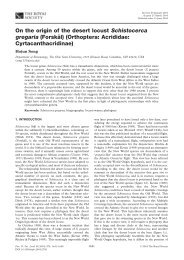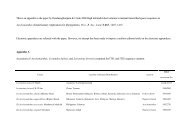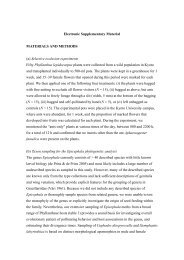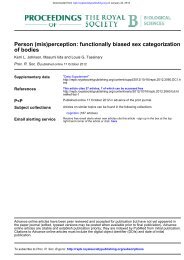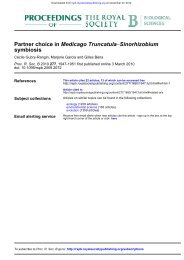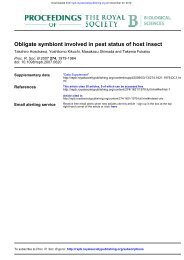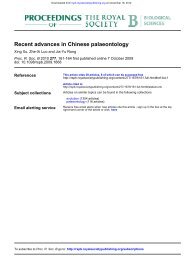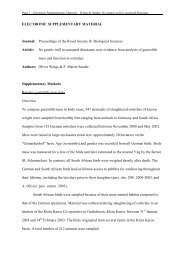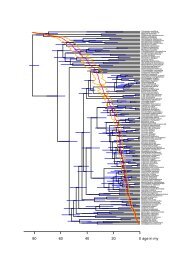Parental Care and Egg Size References - Proceedings of the Royal ...
Parental Care and Egg Size References - Proceedings of the Royal ...
Parental Care and Egg Size References - Proceedings of the Royal ...
You also want an ePaper? Increase the reach of your titles
YUMPU automatically turns print PDFs into web optimized ePapers that Google loves.
Appendix 1: <strong>Parental</strong> <strong>Care</strong> <strong>and</strong> <strong>Egg</strong> <strong>Size</strong> <strong>References</strong><br />
Alford, R. 1999. Ecology: resource use, competition, <strong>and</strong> predation. In R. McDiarmid<br />
<strong>and</strong> R. Altig (eds.), Tadpoles: The Biology <strong>of</strong> Anuran Larvae, pp. 240-278. University <strong>of</strong><br />
Chicago Press, Chicago.<br />
Anstis, M. 2002. Tadpoles <strong>of</strong> South-eastern Australia. New Holl<strong>and</strong>, Sydney.<br />
Barker, J. & Grigg, G. 1977. A Field Guide to Australian Frogs. Rigby Limited,<br />
Adelaide.<br />
Bartlett, R.D. & Bartlett, P.P. 1998. A Field Guide to Florida Reptiles & Amphibians.<br />
Houston, Limited.<br />
Bartlett, R.D. & Barlett, P.P. 1999. A Field Guide to Texas Reptiles & Amphibians<br />
Houston, TaylorWilson Publishing.<br />
Bell, B.D. 1978. Observations on <strong>the</strong> ecology <strong>and</strong> reproduction <strong>of</strong> <strong>the</strong> New Zeal<strong>and</strong><br />
leiopelmid frogs. Herpetologica 34:340-354.<br />
Blommers-Schlosser, R.M.A. 1975. Observations on <strong>the</strong> larval development <strong>of</strong> some<br />
Malagasy frogs, with notes on <strong>the</strong>ir ecology <strong>and</strong> biology (Anura: Dyscophianae,<br />
Scaphiophrynidae <strong>and</strong> Cophylinae). Beaufortia 24:7-26.<br />
Blommers-Schlosser, R.M.A. 1979. Biosystematics <strong>of</strong> <strong>the</strong> Malagasy frogs, I. Mantellinae<br />
(Ranidae). Beaufortia 29:1-75.<br />
Boulenger, G.A. & Sterling, K.B. 1978. The Tailless Batrachians <strong>of</strong> Europe. Manchester,<br />
Ayer Publishing.<br />
Bourne, G.R., Collins, A.C., Holder, A.M. & McCarthy, C.L. 2001. Vocal<br />
communication <strong>and</strong> reproductive behavior <strong>of</strong> <strong>the</strong> frog Colostethus bebeei in Guyana. J.<br />
Herpetol. 35:272-281.
Brust, D. 1993. Maternal brood care by female Dendrobates pumilio, a frog that feeds its<br />
young. Journal <strong>of</strong> Herpetology, 27:96-98.<br />
Busse, K. 1970. <strong>Care</strong> <strong>of</strong> <strong>the</strong> young by male Rhinoderma darwinii. Copeia 1970:395.<br />
Campbell, J.A. 1999. Amphibians & Reptiles <strong>of</strong> Nor<strong>the</strong>rn Guatemala, <strong>the</strong> Yucatan &<br />
Belize<br />
Norman, University <strong>of</strong> Oklahoma Press.<br />
Case, T. & Fisher, R. 1997. A Field Guide to Reptiles & Amphibians <strong>of</strong> Coastal Sou<strong>the</strong>rn<br />
California. La Jolla : Ted Case.<br />
Coe, M. 1974. Observations on <strong>the</strong> ecology <strong>and</strong> breeding biology <strong>of</strong> <strong>the</strong> genus<br />
Chiromantis (Amphibia: Rhacophoridae). J. Zool. Lond. 172:13-34.<br />
Cogger, H.G. 2000. Reptiles & Amphibians <strong>of</strong> Australia<br />
Sanibel, Ralph Curtis Publishing.<br />
Collins, J.T., Collins, S.L. & Hayes, J. 1993. Amphibians & Reptiles in Kansas.<br />
Lawrence, University Press <strong>of</strong> Kansas.<br />
Coloma, L. A. 1995. Ecuadorian frogs <strong>of</strong> <strong>the</strong> genus Colostethus (Anura: Dendrobatidae).<br />
University <strong>of</strong> Kansas Museum <strong>of</strong> Natural History Occasional Papers, 87: 1-72.<br />
Cook, C.L., Ferguson, J.W.H. & Telford. 2001. Adaptive male parental care in <strong>the</strong> giant<br />
bullfrog, Pyxicephalus adspersus. J. Herpetol.<br />
Corben, C.J., Ingram, G.J. & Tyler, M.J. 1974. Gastric brooding: a unique form <strong>of</strong><br />
parental care in an Australian frog. Science 186:94 6-947.<br />
Corkran, CC & Thoms, C. 1996. Amphibians <strong>of</strong> Oregon, Washington <strong>and</strong> British<br />
Colombia. Lone Pine, Edmonton.
Crump, M. 1974. Reproductive strategies in a tropical anuran community. Miscellaneous<br />
Publications <strong>of</strong> <strong>the</strong> Museum <strong>of</strong> Natural History <strong>of</strong> <strong>the</strong> Univerity <strong>of</strong> Kansas, 61:1-68.<br />
Crump, M. 1992. Cannibalism in amphibians. In M. Elgar <strong>and</strong> B. Crespi (eds.),<br />
Cannibalism: Ecology <strong>and</strong> Evolution Among Diverse Taxa, pp. 256-276. Oxford<br />
University Press, Oxford.<br />
De la Riva, I. 1995. A new reproductive mode for <strong>the</strong> genus Adenomera (Amphibia:<br />
Anura: Leptodactylidae): taxonomic implications for certain Bolivian <strong>and</strong> Paraguayan<br />
populations. Studies on Neotropical Fauna <strong>and</strong> Environment 30:15-29.<br />
Degenhardt, W.G., Painter, C.W. & Price, A.H. 1996. Amphibians & Reptiles <strong>of</strong> New<br />
Mexico. Albuquerque, University <strong>of</strong> New Mexico Press.<br />
DeGraaf, R.M. & Rudis, D.D. 1983. Amphibians & Reptiles <strong>of</strong> New Engl<strong>and</strong> Habitats &<br />
Natural History. Amherst : University <strong>of</strong> Massachusetts Press.<br />
Deuchar, E.M. Xenopus: The South African Clawed Frog. Ann Arbor, Books on<br />
Dem<strong>and</strong>.<br />
Dixon, J.R. & Rivero-Blanco, C. 1985. A new dendrobatid frog (Colostethus) from<br />
Venezuela with notes on its natural history <strong>and</strong> that <strong>of</strong> related species. J. Herpetol.<br />
19:177-184.<br />
Dixon, J.R. 2000. Amphibians & Reptiles <strong>of</strong> Texas. College Station, Texas A & M<br />
University Press,<br />
Downie, J.R. 1996. A new example <strong>of</strong> female parental behavior in Leptodactylus validus,<br />
a frog <strong>of</strong> <strong>the</strong> leptodactylid ‘melanotus’ species group. Herp. J. 6:32-34.<br />
Duellman, W.E. 1978. The biology <strong>of</strong> an equatorial herpet<strong>of</strong>auna in Amazonian Ecuador.<br />
Misc. Publ. Mus. Nat. Hist. Univ. Kansas 65:1-352.
Duellman, W.E. & Manness, S.J. 1980. The reproductive behavior <strong>of</strong> some hylid<br />
marsupial frogs. J. Herpetol. 14:213-222.<br />
Duellman, W.E. & Gray, P. 1983. Developmental biology <strong>and</strong> systematics <strong>of</strong> <strong>the</strong> egg-<br />
brooding hylid frogs, genera Flectonotus <strong>and</strong> Fritziana. Herpetologica 39:333-359.<br />
Duellman, W. E., <strong>and</strong> L. Trueb. 1986. Biology <strong>of</strong> Amphibians. McGraw-Hill, New York.<br />
Duellman, W.E. 1992. Reproductive strategies <strong>of</strong> frogs. Sci. Amer. 1992:80-87.<br />
Dundee, H.A., Rossman, D.E. & Beckham, E.C. 1996. Amphibians & Reptiles <strong>of</strong><br />
Louisiana. Baton Rouge : Louisiana State University Press.<br />
Duellman, W.E. 2001. Hylid frogs <strong>of</strong> Middle America, Vol. 1. Contributions to<br />
Herpetology, Vol. 18. Society for <strong>the</strong> Study <strong>of</strong> Amphibians <strong>and</strong> Reptiles, Ithaca, New<br />
York.<br />
Du Preez, L.H. 1996. Field guide <strong>and</strong> key to <strong>the</strong> frogs & toads <strong>of</strong> <strong>the</strong> Free State. Dept. <strong>of</strong><br />
Zoology & Entomology, University <strong>of</strong> <strong>the</strong> Orange Free State.<br />
Ehmann, H. & Swan, G. 1985. Reproduction <strong>and</strong> development in <strong>the</strong> marsupial frog,<br />
Assa darlingtoni (Leptodactylidae, Anura). Pp. 279-285 In: Biology <strong>of</strong> Australasian<br />
Frogs <strong>and</strong> Reptiles (Grigg, G., Shine, R. & Ehmann, H. eds.). <strong>Royal</strong> Zool. Soc. Of New<br />
South Wales, Mosman.<br />
Ellis, M.M. & Henderson, J. 2000. The Amphibia & Reptilia <strong>of</strong> Colorado<br />
L<strong>and</strong>isville : Arment Biological Press.<br />
Gibbons, J. W. & Semlitsch, R.D. 1991. Guide to <strong>the</strong> Reptiles & Amphibians <strong>of</strong> <strong>the</strong><br />
Savannah River Site. A<strong>the</strong>ns, University <strong>of</strong> Georgia Press.<br />
Gibson, R.C. & Buley, K.R. 2004. Maternal care <strong>and</strong> obligatory oophagy in<br />
Leptodactylus fallax: a new reproductive mode in frogs. Copeia 2004:128-135.
Glaw, F. & Vences, M. 1994. A Field Guide to <strong>the</strong> Amphibians <strong>and</strong> Reptiles <strong>of</strong><br />
Madagascar, 2 nd Ed. Moos Druck, Germany.<br />
Glaw, F. & Vences, M. 1996. Neue ergebnisse zur Boophis goudoti-gruppe aus<br />
Madagaskar: bioakustik, fortpflanzungssstrategian und beschreibung von Boophis<br />
rufioculis sp. nov. Salam<strong>and</strong>ra 32:225-242.<br />
Goicoechea, O., Garrdo, O. & Jorquera, B. 1986. Evidence for a trophic paternal-larval<br />
relationship in <strong>the</strong> frog Rhinoderma darwinii. J. Herpetol. 20:168-178.<br />
Gr<strong>and</strong>ison, A.G.C. 1978. The occurrence <strong>of</strong> Nectophrynoides (Anura: Bufonidae) in<br />
Ethiopia. A new concept <strong>of</strong> <strong>the</strong> genus with a description <strong>of</strong> a new species. Monit. Zool.<br />
Italiano Suppl. 11:119-172.<br />
Green, DM & Campbell, RW. 1984. The Amphibians <strong>of</strong> British Columbia. British<br />
Columbia Provincial Museum, Victoria.<br />
Harding, J.H. 1997. Amphibians & Reptiles <strong>of</strong> <strong>the</strong> Great Lakes Region. Ann Arbor,<br />
University <strong>of</strong> Michigan Press.<br />
Henderson, R.W. & Schwartz, A. 1984. A Guide to <strong>the</strong> Identification <strong>of</strong> <strong>the</strong> Amphibians<br />
& Reptiles <strong>of</strong> Hispaniola. Milwaukee, Milwaukee Public Museum.<br />
Henderson, Robert W. ; Schwartz, A., Garity, M.M., Leber, D. 1985. A Guide to <strong>the</strong><br />
Amphibians & Reptiles <strong>of</strong> <strong>the</strong> West Indies, Exclusive <strong>of</strong> Hispaniola. Milwaukee,<br />
Milwaukee Public Museum.<br />
Henkel, F.-W., Schmidt, W. & Kaiser, H. 1998. Amphibians & Reptiles <strong>of</strong> Madagascar<br />
& <strong>the</strong> Mascarene, Seychelles, & <strong>the</strong> Comoro Isl<strong>and</strong>s. Melbourne, Krieger.<br />
Heselhaus, R. 1992. Poison-Arrow Frogs. Bl<strong>and</strong>ford, London.<br />
Hodge, R.P. 1976. Amphibians & Reptiles in Alaska, <strong>the</strong> Yukon & Northwest Territories
Seattle, Alaska Northwest Books.<br />
Hunter, M.L., Calhoun, A.J. & McCollogh, M. 1999. Maine Amphibians & Reptiles<br />
Orono, University <strong>of</strong> Maine Press.<br />
Ibanez, R.D., R<strong>and</strong>, A.S., & Jaramillo, C.A. 1999. The Amphibians <strong>of</strong> Barro Colorado<br />
National Monument, Soberania National Park, <strong>and</strong> Adjacent Areas. D’Vinni Editorial<br />
Limited, Bogota<br />
Inger, R.F., Voris, H.K. & Walker, P. 1986. Larval transport in a Bornean ranid frog.<br />
Copeia 1986:523-525.<br />
Inger, R.F. & Voris, H.K. 1988. Taxonomic status <strong>and</strong> reproductive biology <strong>of</strong> Bornean<br />
tadpole-carrying frogs. Copeia 1988:1060-1061.<br />
Inger, R.F. ; Stuebing, R.B. 1997. A field guide to <strong>the</strong> frogs <strong>of</strong> Borneo. Kota Kinabalu,<br />
Natural History Publications.<br />
Ingram, G.J., Anstis, M. & Corben, C.J. 1975. Observations on <strong>the</strong> Australian<br />
leptodactylid frog, Assa darlingtoni. Herpetologica 31:425-429.<br />
Jacobson, S.K. 1985. Reproductive behavior <strong>and</strong> male mating success in two species <strong>of</strong><br />
glass frogs (Centrolenidae). Herpetologica 41:396-404.<br />
Jungfer, K.-H. 1996. Reproduction <strong>and</strong> parental care <strong>of</strong> <strong>the</strong> coronated treefrog, Ano<strong>the</strong>ca<br />
spinosa (Steindacher, 1864) (Anura: Hylidae). Herpetologica 52:25-32.<br />
Jungfer, K-H & Schiesari, L.C. 1995. Description <strong>of</strong> a Central Amazonian <strong>and</strong> Guianan<br />
tree frog, genus Osteocephalus (Anura, Hylidae), with oophagous tadpoles<br />
Alytes 13:1-13.<br />
Jungfer, K.-H. & Weygoldt, P. 1999. Biparental care in <strong>the</strong> tadpole feeding Amazonian<br />
treefrog, Osteocephalus oophagus. Amphibia-Reptilia 20:235-249.
Kam, Y.C., Chuang, Z.S. & Yen, C.F. 1996. Reproduction, ovipositition-site selection,<br />
<strong>and</strong> tadpole oophagy <strong>of</strong> an arboreal nester, Chirixalus eiffingeri (Rhacophoridae), from<br />
Taiwan. J. Herpetol. 30:52-59.<br />
Kaminsky, S.K., Linsenmair, E. & Ulmar Grafe, T. 1999. Reproductive timing, nest<br />
construction <strong>and</strong> tadpole guidance in <strong>the</strong> African pig-nosed frog, Hemisus marmoratus. J.<br />
Herpetol. 33:119-123.<br />
Kenney, J.S. 1969. The Amphibia <strong>of</strong> Trinidad. Stud. Fauna Curacao & o<strong>the</strong>r Caribbean<br />
Isl<strong>and</strong>s, Vol. XXIX, 1969. Martinus Nijh<strong>of</strong>f, The Hague.<br />
Klemens, MW. 1993. Amphibians <strong>and</strong> Reptiles <strong>of</strong> Connecticut <strong>and</strong> Adjacent Regions.<br />
State Geological <strong>and</strong> Natural History Survey <strong>of</strong> Connecticut, Hartford, CT.<br />
Kok, D, Du Preez, L.H. & Channing, A. 1989. Channel constructioin by <strong>the</strong> African<br />
bullfrog: ano<strong>the</strong>r anuran parental care strategy. J. Herpetol. 23:435-437.<br />
Krugel, P. & Richter, S. 1995. Syncope antenori - A bromeliad breeding frog with free-<br />
swimming, nonfeeding tadpoles (Anura, microhylidae). Copeia 4:955-963.<br />
Kuramoto, M. 1978. Correlations <strong>of</strong> quantitative parameters <strong>of</strong> fecundity in amphibians.<br />
Evolution 32:287-296.<br />
Lang, C. 1995. <strong>Size</strong>-fecundity relationships among stream-breeding hylid frogs. Herp.<br />
Nat. Hist. 3:193-197.<br />
Lannoo, M.J., Townsend, D.S. & Wassersug, R.J. 1987. Larval life in <strong>the</strong> leaves: arboreal<br />
tadpole types, with special attention to <strong>the</strong> morphology, ecology <strong>and</strong> behavior <strong>of</strong> <strong>the</strong><br />
oophagous Osteopilus brunneus (Hylidae) larva. Fieldiana Zoology 38:1-31.<br />
Lee, JC. 2000. A Field Guide to <strong>the</strong> Amphibians <strong>and</strong> Reptiles <strong>of</strong> <strong>the</strong> Maya World.<br />
Cornell University Press, Ithaca.
Leonard, W.P., Brown, H.A., Jones, L.L. & McAllister, K.R. 1996. Amphibians <strong>of</strong><br />
Washington & Oregon. Seattle, Seattle Audubon Society.<br />
Liu, C.C. 1950. Amphibians <strong>of</strong> Western China. 422 pp. Chicago Natural History<br />
Museum, Chicago.<br />
Livezey, R.L. & Wright, A.H. 1947. A syntopic key to <strong>the</strong> salientian eggs <strong>of</strong> <strong>the</strong> United<br />
States. Amer. Midl. Nat. 37:179-222.<br />
Lynch, J.D., Ruiz, P.M. & Rueda, J.V. 1983. Notes on <strong>the</strong> distribution <strong>and</strong> reproductive<br />
biology <strong>of</strong> Centrolene geckoideum Jimenez de la Espada in Colombia <strong>and</strong> Ecuador<br />
(Amphibia: Centrolenidae). Studies on <strong>the</strong> Neotropical Fauna <strong>and</strong> Environment 18:239-<br />
243.<br />
Malhotra, A. & Thorpe, R.S. 1999. Reptiles & Amphibians <strong>of</strong> <strong>the</strong> Eastern Caribbean.<br />
BPR Publishers.<br />
McDiarmid, R.W. & Gorzula, S. 1989. Aspects <strong>of</strong> <strong>the</strong> reproductive ecology <strong>and</strong> behavior<br />
<strong>of</strong> <strong>the</strong> Tepui toads, genus Oreophrynella. Copeia 1989:445-451.<br />
McPeak, R.H. 1999. Amphibians & Reptiles <strong>of</strong> Baja California<br />
Skyline Forest, Monterey.<br />
Minton, S. 1999. Amphibians & Reptiles <strong>of</strong> Indiana. Indianapolis, Indiana Academy <strong>of</strong><br />
Science.<br />
Mitchell, N. & Swan, R. 1996. Terrestrial development in <strong>the</strong> Tasmanian frog,<br />
Bryobatrachus nimbus (Anura: Myobatrachidae): larval development <strong>and</strong> a field staging<br />
table. Proc. Roy. Soc. Tasmania 130:75-80.<br />
Moore, JA. 1969. The frogs <strong>of</strong> Eastern New South Wales. Bull. Am. Mus. Nat. Hist.<br />
121(3). 385 pp.
Morrison, P. 1994. Mammals, Reptiles, & Amphibians <strong>of</strong> Britain & Europe. London, Pan<br />
Books Limited.<br />
Oldfield, B. Moriarty, J.J., Breckenridge, W. J. 1994. Amphibians & Reptiles Native to<br />
Minnesota. Minneapolis, University <strong>of</strong> Minnesota Press.<br />
Ovencdon, A. & Burton, J.S. 1978. A Field Guide to Reptiles & Amphibians <strong>of</strong> Britain &<br />
Europe. London, Hammersmith.<br />
Paris, M.G. 1985. Anfibios de Espana. Extension Agraria Corazon de Maria, Madrid.<br />
Passmore, N.I. & Carru<strong>the</strong>rs, V.C. 1995. South African Frogs: A Complete Guide.<br />
Witwatersr<strong>and</strong> University Press, Johannesburg.<br />
Pickwell, G. 1987. Amphibians & Reptiles <strong>of</strong> <strong>the</strong> Pacific States<br />
Magnolia, Peter Smith Publisher, Incorporated.<br />
Pienaar, U.V., Passmore, N.I., & Carru<strong>the</strong>rs, V.C. 1976. The Frogs <strong>of</strong> <strong>the</strong> Kruger<br />
National Park. Sigma Press, Pretoria.<br />
Prado, C.P. de A., Uetanabaro, M., & Lopes, F.S. 2000. Reproductive strategies <strong>of</strong><br />
Leptodactylus chaquensis <strong>and</strong> L. podicipinus in <strong>the</strong> Pantanal, Brazil. J. Herpetol. 34:135-<br />
139.<br />
Prado, C.P. de A., Uetanabaro, M. & Haddad, C.F.B. 2002. Description <strong>of</strong> a new<br />
reproductive mode in Leptodactylus (Anura: Leptodactylidae), with a review <strong>of</strong> <strong>the</strong><br />
reproductive specialization toward terrestriality in <strong>the</strong> genus. Copeia 2002:1128-1133.<br />
Pyburn, W.F. 1975. A new species <strong>of</strong> microhylid frog <strong>of</strong> <strong>the</strong> genus Synapturanus from<br />
sou<strong>the</strong>astern Colombia. Herpetologica 31:439-443.<br />
Richter, J.D. 1999. A Comparative Methods <strong>of</strong> Approach to <strong>the</strong> Study <strong>of</strong> Oocytes &<br />
Embryos. New York, Oxford University Press.
Roberts, J.D. 1984. Terrestrial egg deposition <strong>and</strong> direct development in Arenophryne<br />
rotunda Tyler, a myobatrachid frog from coastal s<strong>and</strong> dunes at Shark Bay, W.A. Aust.<br />
Widl. Res. 11:191-200.<br />
Rodel, M.O. 1998. A reproductive mode so far unknown in African ranids:<br />
Phyrnobatrachus guineensis Guibe <strong>and</strong> Lamotte, 1961 breeds in treeholes. Herpetozoa<br />
11:19-26.<br />
Rodel, M.-O. 2000. Herpet<strong>of</strong>auna <strong>of</strong> West Africa, Vol. I. Chimaira, Frankfurt.<br />
Rodel, M.-O., Kosuch, J., Veith, M., & Ernst, R. 2003. First record <strong>of</strong> <strong>the</strong> genus<br />
Acanthixalus Laurent, 1944 from <strong>the</strong> upper guinean rain forest, West Africa, with a<br />
description <strong>of</strong> a new species. J. Herpetol. 37: 43-52.<br />
Rodriguez, L.O. & Duellman, W.E. 1994. Guide to <strong>the</strong> Frogs <strong>of</strong> <strong>the</strong> Iquitos Region,<br />
Amazonian Peru. Natural History Museum, Univerisity <strong>of</strong> Kansas, Lawrence, KS.<br />
Sal<strong>the</strong>, S., <strong>and</strong> W. Duellman. 1973. Quantitative constraints associated with reproductive<br />
mode in anurans. In J. Vial (ed.), Evolutionary Biology <strong>of</strong> <strong>the</strong> Anurans: Contemporary<br />
Research on Major Problems, pp. 229-249. University <strong>of</strong> Missouri Press, Columbia.<br />
Savage, J. 2002. The Amphibians <strong>and</strong> Reptiles <strong>of</strong> Costa Rica. University <strong>of</strong> Chicago<br />
Press, Chicago.<br />
Scheel, J.J. 1970. Notes on <strong>the</strong> biology <strong>of</strong> <strong>the</strong> African tree-toad, Nectophryne afra<br />
Buchholz <strong>and</strong> Peters, 1875 (Bufonidae, Anura) from Fern<strong>and</strong>o Poo. Rev. Zool. Bot. Afr.<br />
81:225-236.<br />
Schleich, H.H., Kastle, W. & Kabisch, K. 1995. Amphibians & Reptiles <strong>of</strong> North Africa.<br />
Koeltz Scientific Books.
Sheridan, D. 1997. Key-Guide to <strong>the</strong> Reptiles & Amphibians <strong>of</strong> <strong>the</strong> Central California<br />
Coast. Los Osos : Aryan I. Roest.<br />
Schiotz, A. 1999. Treefrogs <strong>of</strong> Africa. Frankfurt am Main, Meckenheim, Germany.<br />
Schwartz, A. & Henderson, R.W. 1991. Amphibians <strong>and</strong> Reptiles <strong>of</strong> <strong>the</strong> West Indies.<br />
University <strong>of</strong> Florida Press, Gainesville, Florida.<br />
Stebbins, RC. 1954. Ampibians <strong>and</strong> Reptiles <strong>of</strong> Western North America. McGraw-Hill,<br />
New York.<br />
Stephenson, E.M. & Stephenson, N.G. 1957. Field observations on <strong>the</strong> New Zeal<strong>and</strong><br />
frog, Leiopelma Fitzinger. Trans. Roy. Soc. New Zeal<strong>and</strong> 84:867-882.<br />
Stewart, MM. 1967. Amphibians <strong>of</strong> Malawi. State University <strong>of</strong> New York Press,<br />
Albany.<br />
Taylor, J. & Rorer, A. 1993. The Amphibians & Reptiles <strong>of</strong> New Hampshire. Concord,<br />
New Hampshire Fish & Game Department.<br />
Thompson, R.L. 1996. Larval habitat, ecology <strong>and</strong> parental investment <strong>of</strong> Osteopilus<br />
brunneus (Hylidae). In: Contributions to West Indian herpetology: a tribute to Albert<br />
Schwartz. (Powell, R. & Henderson, R.W., eds.). Contributions to Herpetology Vol. 12.<br />
Society for <strong>the</strong> Study <strong>of</strong> Amphibians <strong>and</strong> Reptiles, Ithaca, New York.<br />
Tyler, M.J. 1994. Australian Frogs: A Natural History. Cornell University Press, Ithaca.<br />
van Dijk, D.E. 1997. <strong>Parental</strong> care in Hemisus (Anura: Hemisotidae). S. Afr. J. Zool.<br />
32:56-57.<br />
Vaz-Ferreira, R. & Gehrau, A. 1974. Proteccion de la prole en leptodactylidos. Rev. Biol.<br />
Uruguay 2:59-62.
Vences, M., Glaw, F. & Zapp, C. 1999. Bemerkungen zu eizahlen und eigroben bei<br />
madagassischen froschen der gattugen Tomopterna, Aglyptodactylus, Boophis und<br />
Mantidacytlus (Amphibia: Ranidae). Salam<strong>and</strong>ra 35:77-82.<br />
Vogt, R.C., Hine, R. & Nickerson, M. 1981. Natural History <strong>of</strong> Amphibians & Reptiles<br />
<strong>of</strong> Wisconsin. Milwaukee, Milwaukee Public Museum.<br />
Wager, V.A. 1986. Frogs <strong>of</strong> South Africa. Delta Books Ltd., Craighall.<br />
Wells, K. D. 1980. Behavioral ecology <strong>and</strong> social organization <strong>of</strong> a Dendrobatid frog<br />
(Colostethus inguinalis). Behavioral Ecology <strong>and</strong> Sociobiology, 6:199-209.<br />
Weygoldt, P. 1980. Complex brood care <strong>and</strong> reproductive behaviour in captive poison-<br />
arrow frogs, Dendrobates pumilio O. Schmidt. Behavioral Ecology <strong>and</strong> Sociobiology,<br />
7:329- 332.<br />
Weygoldt, P. 1987. Evolution <strong>of</strong> parental care in dart poison frogs (Amphibia:<br />
Dendrobatidae). Zeitschrift Zoologische Systematik:Evolution-forsch.van der Meijden,
Genus Species <strong>Egg</strong><strong>Size</strong> PC<br />
Acanthixalus sonjae 3.22 1<br />
Acris crepitans 1.5333 0<br />
Acris gryllus 1.05 0<br />
Adelotus brevis 1.975 1<br />
Adenomera <strong>and</strong>reae 3 0<br />
Adenomera hylaedactyla 3 0<br />
Afrixalus brachycnemis 1.2 0<br />
Afrixalus fornasinii 1.6 0<br />
Agalychnis annae 3.3 0<br />
Agalychnis calcalifer 4 0<br />
Aglyptodactylus laticeps 1 0<br />
Aglyptodactylus madagascariensi 1.35 0<br />
Allobates femoralis 1.9 1<br />
Alytes cisternasii 3.25 1<br />
Alytes muletensis 4.5 1<br />
Alytes obstetricans 3.55 1<br />
Amalops jerboa 1.3 0<br />
Anhydrophryne rattrayi 2.6 1<br />
Ano<strong>the</strong>ca spinosa 1.62 1<br />
Arenophryne rotunda 5.5 0<br />
Arthroleptella hewitti 3 0<br />
Arthroleptella lightfooti 4.25 0<br />
Arthroleptis stenodactylus 2 1<br />
Arthroleptis wahlbergii 2.5 1<br />
Ascaphus truei 4.3333 0<br />
Assa darlingtoni 2.45 1<br />
Atelopus carbonerensis 1.5 0<br />
Atelopus spmarius 2 0<br />
Bombina bombina 2 0<br />
Bombina maxima 3.8 0<br />
Boophis albilabris 2.5 0<br />
Boophis erythrodactylus 2 0<br />
Boophis luteus 2.25 0<br />
Boophis madagascariensis 3 0<br />
Brachycephalus ephippum 5.2 0<br />
Breviseps adsperus 4.5 1<br />
Breviseps fuscus 5 1<br />
Bryobatrachus nimbus 3.5 1<br />
Bufo alvarius 1.4 0<br />
Bufo americanus 1.2 0<br />
Bufo angusticeps 1.75 0<br />
Bufo asper 1.1 0<br />
Bufo boreas 1.65 0<br />
Bufo bufo 2 0<br />
Bufo calamita 1.5 0<br />
Bufo canorus 2.1 0<br />
Bufo cognatus 1.1833 0<br />
Bufo coniferus 1.8 0<br />
Bufo debilis 1 0<br />
Bufo dombensis 1.7 0<br />
Bufo fastidiosus 4.3 0<br />
Bufo fenouheti 1.8 0<br />
Bufo garmani 1.2 0<br />
Bufo granulosus 1 0<br />
Bufo gutteralis 1.45 0<br />
Bufo maculatus 1.3 0<br />
Bufo marinus 1.55 0<br />
Bufo mauritanicus 1.5 0
Bufo microscaphus 1.55 0<br />
Bufo quercicus 0.995 0<br />
Bufo rangeri 1.3 0<br />
Bufo regularis 1.15 0<br />
Bufo taitanus 2.5 0<br />
Bufo terrestris 1.2 0<br />
Bufo valliceps 1.215 0<br />
Bufo vertebralis 1.8 0<br />
Bufo viridis 1.25 0<br />
Bufo woodhousei 1.25 0<br />
Cacosternum boettgeri 0.75 0<br />
Cacosternum capense 1 0<br />
Callulops robusta 6.75 1<br />
Capensibufo rosei 2.6 0<br />
Capensibufo tradouwi 2 0<br />
Centrolene geckoideum 3.75 1<br />
Ceratophrys cornuta 2 0<br />
Chiasmocleis bassleri 1 0<br />
Chiasmocleis ventrimaculata 1.25 0<br />
Chiraxalus eiffingeri 2.5 1<br />
Chiraxalus idiootocus 1.95 0<br />
Chiromantis rufescens 2.8 0<br />
Chiromantis xerampelina 1.9 1<br />
Cochranella granulosa 1.5 0<br />
Cochranella munozorum 1.5 0<br />
Colostethus beebei 2 1<br />
Colostethus bromelicola 1.7 1<br />
Colostethus marchesianus 1.75 1<br />
Colostethus sauli 1.5 1<br />
Colostethus stepheni 2 1<br />
Colostethus trinitatis 3.5 1<br />
Colostethus vertebralis 3 1<br />
Cophixalus neglectus 4.3 1<br />
Cophixalus parkeri 3.5 1<br />
Crinia georgiana 2.25 0<br />
Crinia glauteri 1.15 0<br />
Crinia insignifera 1.3 0<br />
Crinia parainsignifera 1.15 0<br />
Crinia psuedoinsignifera 1.45 0<br />
Crinia signifera 1.475 0<br />
Crinia tasmaniensis 2.2025 0<br />
Crinia tinnula 1.15 0<br />
Cryptobatrachus boulengeri 4 1<br />
Cryptobatrachus fuhrmanni 4 1<br />
Cyclorana alboguttata 1.3 0<br />
Cyclorana brevipes 1.3 0<br />
Cyclorana longipes 1.35 0<br />
Cyclorana novaeholl<strong>and</strong>iae 1.5 0<br />
Dendrobates auratus 2 1<br />
Dendrobates histrionicus 1.5 1<br />
Dendrobates lehmanni 1.5 1<br />
Dendrobates leucomelas 3.93 1<br />
Dendrobates pumilio 1.1 1<br />
Dendrobates reticulatus 2 1<br />
Dendrobates ventrimaculatus 2 1<br />
Discoglossus pictus 1.625 0<br />
Duellmanohyla rufiocullis 2.36 0<br />
Duellmanohyla uranochoa 2.59 0<br />
Elastocleis bicolor 1 0
Eleu<strong>the</strong>rodactylus angelicus 6.8 1<br />
Eleu<strong>the</strong>rodactylus cundalli 4.2 1<br />
Eleu<strong>the</strong>rodactylus jasperi 3.3 1<br />
Eleu<strong>the</strong>rodactylus johnstonei 2.965 1<br />
Eleu<strong>the</strong>rodactylus latrans 6.75 1<br />
Epipedobates parvulus 3 1<br />
Epipedobates pictus 2 1<br />
Epipedobates silverstonei 2 1<br />
Epipedobates trivittatus 3 1<br />
Fejevarya limnocharis 1.13 0<br />
Flectonotus fissilis 3 1<br />
Flectonotus fitzgeraldi 3 1<br />
Flectonotus pygmaeus 3 1<br />
Fritziana goeldi 4 1<br />
Gastrophryne carolinesis 1.1 0<br />
Gastrophryne olivacea 1.075 0<br />
Gastro<strong>the</strong>ca argenteovirens 3 1<br />
Gastro<strong>the</strong>ca cornuta 9.8 1<br />
Gastro<strong>the</strong>ca fissipes 10 1<br />
Gastro<strong>the</strong>ca galeata 5 1<br />
Gastro<strong>the</strong>ca marsupiata 2 1<br />
Gastro<strong>the</strong>ca microdisca 8 1<br />
Gastro<strong>the</strong>ca monticola 3 1<br />
Gastro<strong>the</strong>ca ovifera 8 1<br />
Gastro<strong>the</strong>ca plumbea 4 1<br />
Gastro<strong>the</strong>ca riobambae 3 1<br />
Geocrinia laevis 2.475 0<br />
Geocrinia leai 1.85 0<br />
Geocrinia rosea 2.35 0<br />
Geocrinia victoriana 3.1 0<br />
Hamptophryne boliviana 1 0<br />
Heleophryne purcelli 3.8 0<br />
Heleophryne regis 3.6 0<br />
Hemiphractus fasciatus 7 1<br />
Hemiphractus panamensis 6 1<br />
Hemiphractus probocideus 2.5 1<br />
Hemiphractus scutatus 10 1<br />
Hemisus guttatus 2.5 1<br />
Hemisus marmorata 3.4167 1<br />
Heterixalus alboguttaus 1.5 0<br />
Heterixalus betsileo 1.6 0<br />
Hoplobatrachus occipitalis 5 0<br />
Hoplophryne sp. 4.75 0<br />
Hyla alboguttata 1.5 0<br />
Hyla <strong>and</strong>ersoni 1.3 0<br />
Hyla arborea 1.5 0<br />
Hyla arboresc<strong>and</strong>ens 2.15 0<br />
Hyla arenicolor 2.085 0<br />
Hyla avivoca 1.17 0<br />
Hyla bifurca 1.5 0<br />
Hyla boans 2 1<br />
Hyla calcarata 1.5 0<br />
Hyla calypsa 3.6 0<br />
Hyla chrysoscelis 1.15 0<br />
Hyla cinerea 1.2 0<br />
Hyla ebraccata 1.3 0<br />
Hyla femoralis 1 0<br />
Hyla geographica 1 0<br />
Hyla gratiosa 1.45 0
Hyla juanitae 2.19 0<br />
Hyla lancasteri 4.3 0<br />
Hyla lanciformis 2 0<br />
Hyla leucophyllata 1.5 0<br />
Hyla marmorata 1.5 0<br />
Hyla meridionalis 1.3 0<br />
Hyla minuta 1 0<br />
Hyla multifasciata 1 0<br />
Hyla parviceps 1 0<br />
Hyla phyllognatha 3.08 0<br />
Hyla pictipes 2.44 0<br />
Hyla platydactyla 2.5 1<br />
Hyla pseudopuma 1.7 0<br />
Hyla raniceps 1 0<br />
Hyla regilla 1.3 0<br />
Hyla rivularis 2.36 0<br />
Hyla rosenbergi 1.95 1<br />
Hyla sarayacuensis 2 0<br />
Hyla squirella 0.9 0<br />
Hyla sumichrasti 1.61 0<br />
Hyla taeniopus 2.19 0<br />
Hyla tica 2.32 0<br />
Hyla triangulum 1.5 0<br />
Hyla versicolor 1.35 0<br />
Hylinobatrachium colymbiphyllum 1.5 1<br />
Hylinobatrachium fleischmanni 2 1<br />
Hylinobatrachium valeroi 2 1<br />
Hymenochirus boettgeri 0.75 0<br />
Hyperolius argus 1 0<br />
Hyperolius nasutus 0.975 0<br />
Hyperolius semidiscus 1 0<br />
Hyperolius tuberlinguis 1.5 0<br />
Hypopachus cuneus 1 0<br />
Hypopachus variolosus 1 0<br />
Kaloula macropicta 1.5 0<br />
Kaloula rugifera 1.5 0<br />
Kassina maculata 1.5 0<br />
Kassina senegalensis 1.7 0<br />
Kyarranus sphagnicolus 3.35 1<br />
Lechriodus fletcheri 1.7 0<br />
Leiopelma archeyi 4.5 1<br />
Leiopelma hochstetteri 5.5 1<br />
Lepidobatrachus laevis 2.5 0<br />
Leptodactylus chaquensis 1.5 1<br />
Leptodactylus fallax 1.6 1<br />
Leptodactylus fuscus 2 1<br />
Leptodactylus labialis 1.775 0<br />
Leptodactylus melanotus 1.25 0<br />
Leptodactylus mystaceus 2.4 0<br />
Leptodactylus pentadactylus 2.7 0<br />
Leptodactylus podicipinus 1.1 1<br />
Leptodactylus rhodomystax 3 0<br />
Leptopelis natalensis 3 1<br />
Limnodynastes dumerilli 1.7 0<br />
Limnodynastes interioris 1.7 0<br />
Limnodynastes ornatus 1.11 0<br />
Limnodynastes peronii 1.5 0<br />
Limnodynastes spenceri 1.5 0<br />
Limnodynastes tasmaniensis 1.14 0
Limnonectes blythii 1.55 1<br />
Limnonectes macrodon 1.4 0<br />
Limnonectes microdisca 4.5 1<br />
Limnonectes palavensis 2.29 1<br />
Limnonects finchi 1.96 1<br />
Lithodytes lineatus 2 0<br />
Litoria caerula 1.31 0<br />
Litoria freycineti 1.5 0<br />
Litoria genimaculata 2.35 0<br />
Litoria inermis 1.35 0<br />
Litoria lesueuri 1.44 0<br />
Litoria nasuta 1.15 0<br />
Litoria pallida 1.3 0<br />
Litoria pearsoniana 1.2 0<br />
Litoria peronii 1.5 0<br />
Litoria phyllochroa 1.23 0<br />
Litoria rothii 1.35 0<br />
Litoria rubella 1.05 0<br />
Litoria spenceri 1.6 0<br />
Litoria subgl<strong>and</strong>ulosa 1.6 0<br />
Litoria tornieri 1.4 0<br />
Litoria verreauxi 1.21 0<br />
Litoria wotjulumensis 1.75 0<br />
Mantella aurantiaca 1.75 0<br />
Mantidactylus betsileanus 2.5 0<br />
Mantidactylus bicalcaratus 1.9 1<br />
Mantidactylus depressiceps 3 0<br />
Mantidactylus punctatus 1.9 0<br />
Mantidactylus ulcerosus 2.5 1<br />
Megistolotis lignarius 1.85 0<br />
Microhyla carolinensis 1.2 0<br />
Microhyla inornata 2.1 0<br />
Myersiella microps 3 1<br />
Myobatrachus gouldii 5.06 0<br />
Nectophryne afra 3.5 1<br />
Nectophrynoides malcomi 2.6 1<br />
Nectophrynoides tornieri 3.5 1<br />
Neobatrachus sudelli 1.54 0<br />
Oreophryne anulata 3.4 1<br />
Oreophrynella quelchii 3 1<br />
Osteocephalus buckleyii 1 0<br />
Osteocephalus oophagus 1.74 1<br />
Osteocephalus taurinus 1 0<br />
Osteopilus brunneus 0.71 1<br />
Osteopilus septentrionalis 3 0<br />
Paracrinia haswelli 1.64 0<br />
Paratelmatobius cardusoi 1.66 0<br />
Paratelmatobius lutzii 1.9 0<br />
Pelobates cultripes 2 0<br />
Pelodytes punctatus 1.75 0<br />
Philoria frosti 3.9 1<br />
Phrynobatrachus guineensis 3 0<br />
Phrynobatrachus latifrons 0.8 0<br />
Phrynohyas coriacea 2 0<br />
Phrynohyas resinifictrix 1.58 1<br />
Phrynohyas zonata 2.75 0<br />
Phrynomantis bifasciatus 1.3 0<br />
Phyllobates terribilis 2.5 1<br />
Phyllobates vittatus 2.5 1
Phyllodytes luteolus 1.1 1<br />
Phyllomedusa medinai 2 0<br />
Phyllomedusa psilopygion 4.3 0<br />
Phyllomedusa tomopterna 3.25 0<br />
Phyllomedusa trinitatis 3 0<br />
Phyllomedusa vallianti 2.25 0<br />
Physalaemus cuvieri 1.9 0<br />
Physalaemus epihippifer 1.5 0<br />
Physalaemus petersi 1 0<br />
Pipa pipa 6 1<br />
Platymantis guen<strong>the</strong>ri 8.7 1<br />
Platymantis meyeri 7 1<br />
Platypelis gr<strong>and</strong>is 4 1<br />
Plectrohyla acanthodes 2.9 0<br />
Plectrohyla guatemalensis 2 0<br />
Plectrohyla harwegi 2.5 0<br />
Plectrohyla sagorum 1.7 0<br />
Plethodontohyla notosticta 3.05 1<br />
Plethodontohyla tuberata 3.75 1<br />
Polypedates leucomystax 1.85 0<br />
Probreviceps rhodesianus 5 1<br />
Pseudacris nigrita 0.95 0<br />
Pseudacris ocularis 0.7 0<br />
Pseudacris streckeri 1.38 0<br />
Pseudophryne australis 2.775 1<br />
Pseudophryne bibroni 2.125 1<br />
Pseudophryne corroboree 3.25 1<br />
Psuedacris brachyphona 1.55 0<br />
Psuedacris crucifer 1.175 0<br />
Psuedacris ocularis 0.95 0<br />
Psuedacris triseriata 1.03 0<br />
Ptychadena bibroni 1.675 0<br />
Ptychadena mascarienensis 1.1 0<br />
Ptychadena oxyrhychus 1.3 0<br />
Ptychadena schubotzi 1.3 0<br />
Ptychohyla hypomykter 2.38 0<br />
Pyxicephalus adspersus 2 1<br />
Rana aurora 2.475 0<br />
Rana boylei 2.125 0<br />
Rana cancrivora 1.625 0<br />
Rana cascade 2.225 0<br />
Rana catesbiana 1.3 0<br />
Rana japonica 1.75 0<br />
Rana nigromaculata 1.8 0<br />
Rana porosa 1.62 0<br />
Rana pretiosa 2.135 0<br />
Rana ridibunda 1.63 0<br />
Rana saharica 1.5 0<br />
Rana slyvatica 1.9667 0<br />
Rana temporaria 2.5 0<br />
Rhacophorus arualis 2.5 0<br />
Rhacophorus pardalis 3 0<br />
Rheobatrachus silus 4.7 1<br />
Rhinoderma darwini 4 1<br />
Rhinoderma rufum 2.5 1<br />
Scaphiophryne calcarata 1 0<br />
Scaphiopus couchii 1.45 0<br />
Scaphiopus holbrookii 1.7 0<br />
Schismaderma carens 2.05 0
Scinax boesmani 1 0<br />
Scinax boulengeri 1.55 0<br />
Scinax cruentomma 1 0<br />
Scinax dayi 2.45 0<br />
Scinax funerea 1.1 0<br />
Scinax garbei 1.25 0<br />
Scinax nebulosa 1 0<br />
Scinax rubra 1.25 0<br />
Semnodactylus wealii 1.7 0<br />
Smilisca baudinii 1.3 0<br />
Smilisca cyanosticta 1.2 0<br />
Spea bombifroms 1.43 0<br />
Spea hammondi 1.305 0<br />
Spea multiplicata 1.34 0<br />
Sphaenorynchus carneus 1 0<br />
Sphaenorynchus lacteus 1 0<br />
Staurois chunganensis 2.8 0<br />
Stefania evansi 9 1<br />
Stephopaedes anotis 2.5 0<br />
Synapturanus mir<strong>and</strong>aribeiroi 2.635 1<br />
Syncope antenori 1.6 1<br />
Taudactylus eugellensis 2.4 0<br />
Taudactylus liemi 2.1 0<br />
Tomopterna cryptotis 1.5 0<br />
Tomopterna delel<strong>and</strong>iii 1.5 0<br />
Tomopterna krugerensis 1.2 0<br />
Tomopterna marmorata 2 0<br />
Uperoleia crassa 2 0<br />
Uperoleia rugosa 1.25 0<br />
Appendix 2: Species in <strong>the</strong> comparative analyses, with data on egg size <strong>and</strong> parental care.<br />
<strong>Parental</strong> care categories: PC = parental care present (1), or absent (0).



